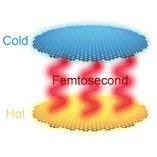27 February 2017
Electronic and optical processes in nanoscale devices produce large concentration of heat, which can limit their performance and cause structural damage. Heat management at this scale is thus one of the main burdens in the design of nanodevices, which is typically dealt with by using conventional thermal conductivity to cool the involved material. This however is a relatively slow and harmful procedure.
In a paper entitled “Ultrafast radiative heat transfer”, published today in Nature Communications, Renwen Yu, Alejandro Manjavacas and ICREA Professor at ICFO Javier García de Abajo, leader of the Nanophotonics Theory Group, use the extraordinary optical and thermal properties of graphene to show that radiative heat transfer is a cleaner process that does not involve undesired inelastic excitations of the materials. Likewise, it occurs at a much faster pace than heating of the atomic lattice.
The extreme concentration of electromagnetic energy associated with graphene plasmons -the collective electron excitations of this material- combined with its record-low electronic heat capacity -a property arising from the unique electronic structure of graphene- allow researchers to show that more than 50% of the electronic heat accumulated by a graphene island can be transferred within a few hundred femtoseconds to a cooler neighboring island. This unexpected finding leads to an unprecedented situation, as all previous experimental and theoretical radiative heat transfer studies have claimed that radiative transfer occurs at a rate that is orders of magnitude lower than heat diffusion through the atomic lattice. Apart from its interest from a fundamental viewpoint, this discovery shows that radiative heat transfer using graphene and other atomically thin materials is bound to profoundly transform the way nanoscale devices are designed.

Ultrafast radiative heat transfer
Radiative heat transfer makes its debut from a negligible to a dominant effect in graphene.

Ultrafast radiative heat transfer











